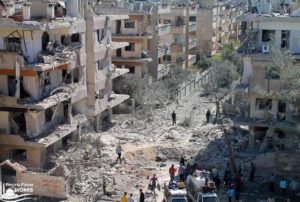Syrian conflict ratchets up
 The bitter and bloody seven-year-long conflict in Syria is entering a deadly endgame phase as the Syrian government forces unleash an offensive to take the last major enclaves of opposition at Nawa and Daraa in the country’s south-east.
The bitter and bloody seven-year-long conflict in Syria is entering a deadly endgame phase as the Syrian government forces unleash an offensive to take the last major enclaves of opposition at Nawa and Daraa in the country’s south-east.
As many as 230,000 people have been displaced following the fighting with many stranded along the closed border with Jordan.
The UN is warning of a new catastrophe while drawing up emergency plans to respond to a fresh humanitarian crisis.
Having secured the centre of the country, including key pockets of resistance in the Damascus suburbs, the Syrian government has set its sights on rebel-held parts of southern Syria, which lies on a strategic artery to Jordan.
This part of Syria has been calm for the past year thanks to an internationally brokered ceasefire, but a renewed government offensive, backed by Russian airstrikes, has seen tens of thousands flee.
The UN has warned the fighting may also cut trade routes within Syria and interrupt imports from Jordan, making it harder for people to get food and other basic supplies.
The EU has also warned of the potentially “devastating” humanitarian consequences of the all-out offensive.
Jordan closed the door to the vast majority of refugees after a suicide car bombing on its borders in June 2016.
Now, the concern is that a new exodus of displaced civilians from around Daraa, some of whom are already on the desert frontier, will have no safe place to go.
UN documents reveal concerns that if Jordan remains sealed off, people displaced by the new offensive could end up in a similar situation to the 50,000-plus Syrians already stuck along the harsh desert no-man’s-land on the Syria-Jordan border known as the “berm”.
They are sheltering in an informal camp near Rukban, 250 kilometres north-east of Daraa city, because they were refused entry to Jordan as refugees.
The Rukban camp houses fighters and criminal gangs as well as civilians, and is sandwiched between sand mounds “or berms” that mark the north and south of the Jordan-Syria border.
The UN’s worst-case scenario seems to be that the new offensive will create a larger spontaneous desert camp up against the border which could still be an area of air and land conflict.
Aid agencies are preparing for the offensive by stockpiling food and medical supplies in rebel-controlled areas in Syria.
But this work carries the risk of air attacks and looting. And there are also fears of indiscriminate revenge attacks by Syrian troops against people in rebel areas.
Observers say these risks to civilians depend in part by the sort of resistance rebels in the south put up.
But the rebel-held areas are already nearly split in two by government-held territory, linked only by a two-kilometre strip of land near the Jordanian border.
The Syrian government’s strategy seems to be to divide and besiege. This is what happened in eastern Aleppo and Ghouta where densely-populated rebel pockets were besieged and subjected to heavy and indiscriminate bombardment.
Perhaps the one hope for a less than catastrophic end is that Jordan has significant influence over some of the rebel groups and may be able to broker a non-violent transfer of power in many areas.
Another potential and concerning scenario is the possibility that groups of Syrians head in large numbers to the Israeli-occupied Golan Heights where the Israeli army has recently been turning away displaced Syrians.
Laurie Nowell
AMES Australia Senior Journalist












